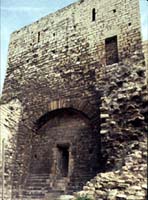| |
 |
Lincoln Lincoln Castle |
Lincoln's origins lie in the Roman period when a fortress was built on high ground overlooking the valley of the River Witham (to the south) at a point where it was crossed by the Roman road now known as Ermine Street which linked London and the north of Britain. By the 2nd century the fortress had become a walled town which was extended down the valley side. The Roman walls offered security to Anglo-Saxon and Viking settlers and in 1068 the defensive and strategic capabilities of Lincoln appealed to William I. His castle was built in the south-west corner of the upper walled town, the remainder of which was used as an outer bailey.
The castle defences existed first of all as an earthen rampart which, on the south-east and south-west sides, was thrown up over the Roman wall and over the Roman west gate. Lincoln Castle is unusual in having two mottes. The first lies astride the defences near the south-west corner and the second which may be mid 12th century is at the south-east.
The castle was first walled c. 1100 and there is distinctive herringbone masonry in places. The east and west gates are probably of similar date. The western gate house is well preserved with a massive tower of two storeys, in front of which was a barbican. The east gate is largely late medieval, but the Norman tunnel vault survives.
It is thought that the years 1129-36 a stone tower was built on the first motte. What is now known as the Lucy Tower, after the Countess of Chester whose family had been involved in government of Lincolnshire since the Conquest, now stands to about half its original height. On each side were subsidiary towers, that to the west containing a latrine block and that to the east a chapel. In the south-east corner of the castle is a structure now known as the Observatory Tower which is also mid 12th century in origin and the motte at this location may be of the same date.
Lincoln castle played an important part in the civil wars of King Stephen and the Empress Matilda. In 1141 it was held by Ranulf, Earl of Chester, Lucy's third husband, and Stephen was captured at the Battle of Lincoln trying to dislodge him.
Bibliography
Pevsner, N and Harris, J., 1989. The Buildings of England, Lincolnshire (London, Penguin, revised ed. By N Antram)
Stocker, D. and Vince, A., 1997. 'The early Norman castle at Lincoln and a re-evaluation of the original west tower of Lincoln cathedral', Medieval Archaeology 41, 223-33